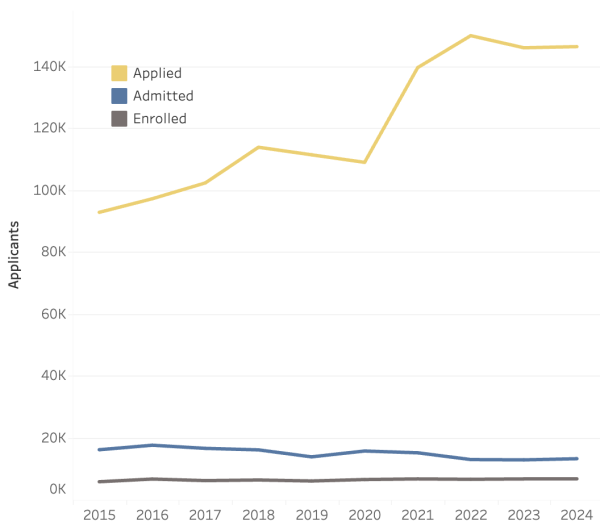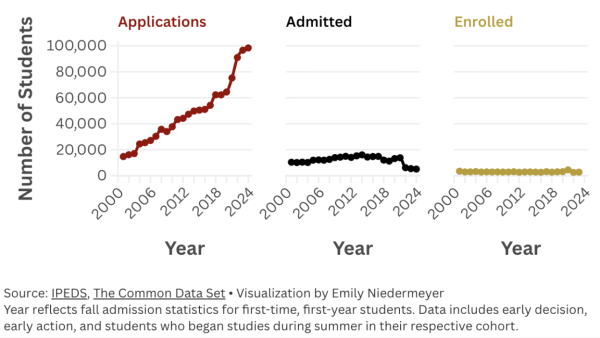
Maya Gest ‘26
GPA vs. test score graphs provide one way to predict the probability of being accepted at a college, but there are many more factors.
As rising high school juniors and seniors begin to do their college research, their friends and family talk about getting into an Ivy League school, or according to Forbes, maybe even some of the “New Ivies.” People may talk to their parents and hear about how they got into some of these schools with much lower test scores. They might also hear how their parents only applied to two or three schools, and got into them all with relative ease.
For a lot of students, seeing the current expectations laid out by colleges can be incredibly daunting. Between the stress of studying for standardized testing, writing the seemingly infinite number of essays colleges ask for, and trying to stay on top of senior year academics, students can start to feel incredibly unsure about their future.
According to a study from The Princeton Review, 73% of high school students feel above average levels of stress having to do with the college application process. But when did it become like this? What has happened over time that has raised the standards for college applications to be so high, and the acceptance rates to be so low?
To start, colleges are receiving more applications than before. According to the Common Application, first year applications are up 6% from the 2023-24 to 2024-25 application cycle, with a total of 8.5 million applications coming from 1.4 million applicants. The Common App states that from the 2023-24 to 2024-25 application cycle, there was a 1% increase in applicants. While that may not seem like a lot, that trend has continued to be on the rise for many years.
Take the most applied to university in the United States, the University of California, Los Angeles, for example. According to UCLA’s website, in 2015, just ten years ago, they received a total of 93 thousand applications. In 2024, they received a total of 146 thousand applications. Yet, despite the number of applications, the number of students that UCLA is accepting has stayed the same, leading to a decrease in acceptance rates. According to data from Ivy Coach, UCLA’s acceptance rate went down by 9% from 2015 to 2023. With top colleges not opening up more spots for students, their acceptance rates will continue to go down.

Another reason the college admissions scene has become so competitive is the culture surrounding standardized testing. Elite universities require high standardized test scores, and they seem to be getting higher as time goes on. As an example, look at Duke University. According to Duke’s website, their median SAT score is between 1520-1570 (out of a 1600 point scale). According to College Tuition Compare, back in the 2015-16 application cycle, the median SAT score was around 1460.
One of the many reasons for this increase is the implementation of test optional policies. According to Sara Harberson, as these policies rose into place (both with the pandemic limiting the ability to test and the general rise in popularity of these policies), fewer students are reporting their scores unless they are in the top percentile. When only high test scores are being submitted, the data gets skewed, and the average becomes inflated, raising the standards for what is needed to get in.
Seeing students boast online about their scores, claiming that they achieved them with ease, perpetuates the stress around testing. As these standards continue to get higher, parents and students increasingly feel the need to invest in tutoring for standardized testing to ensure that their scores are as high as possible. Even if families cannot afford paid tutoring, free resources like Khan Academy and practice tests created by the College Board (although limited) have risen in popularity as well.
Finally, some schools have just done a complete overhaul of their marketing strategies to make their schools seem more selective. Northeastern receives an incredible number of applicants per year. According to Northeastern’s website, with the 2023-24 application cycle they received 98 thousand applications. Their acceptance rate was at 5%. According to Ivy Coach, back in 2015 their acceptance rate was roughly 32%. According to the Huntington News, in 2001 the acceptance rate was around 70%.

This change only happened, though, because Northeastern’s presidents felt the need to rebrand to make their school seem more competitive. According to Boston Magazine, previous Northeastern president Richard Freeland had a strong desire to get into the top 100 schools in the U.S. News & World Report “Best Colleges” rankings. According to Freeland, it was a “life-or-death matter.” In order to do this, they used some strategies to adjust how their statistics appeared to people.
Northeastern’s acceptance rate is calculated based on how many students they accept into their Boston campus for the fall semester. As of 2014, U.S. News did not require data from spring admissions to calculate their acceptance rates, which would allow Northeastern to manipulate their apparent selectivity.
For some Northeastern students, they spend their first semester in their N.U. in-program, which allows them to study abroad for the first semester, and then return to campus after that. According to Boston Magazine, According to Boston Magazine, students who receive this option have “lower grades and SAT scores” than most of the other admitted students. Since they are not on Northeastern’s campus, they are not counted in with the acceptance stats for the rest of the incoming fall class.
These actions result in students feeling that the school is harder to get into, and that it is uber-selective (which ultimately, it is). When people see these low stats, it can make the school seem better (as in many people’s minds, selectivity is equivalent to how good a school is).
Overall, the pressure to be the best is everywhere, and when resources like the Common App have made it so accessible to apply to a multitude of schools at once, the urge to apply to as many as possible is always there.
After reading this article, you may be wondering—how do I ensure that I can get into all of the schools that I want to? And honestly, there’s no way to ensure that and there never really has been. Standards are high, and the pressure is higher. The only thing to do is to submit your applications, and hope for the best. If you truly have given it your all, know that you have done the best that you can, and that you have put your best foot forward. Good luck!